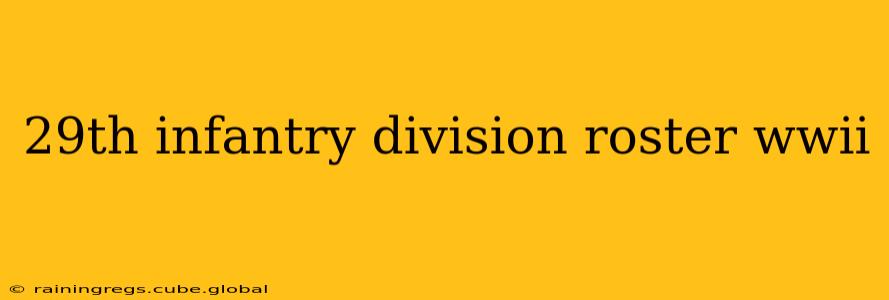The 29th Infantry Division, nicknamed the "Blue and Gray," holds a distinguished place in World War II history. Comprising soldiers from Virginia, Maryland, and the District of Columbia, this National Guard division saw extensive action across Europe, leaving an indelible mark on the conflict. While a complete, publicly accessible roster for the entire division is not readily available due to privacy concerns and the sheer volume of personnel involved, this article explores the resources available to researchers seeking information about specific individuals and units within the 29th.
Where Can I Find the 29th Infantry Division Roster?
Unfortunately, there isn't a single, comprehensive, online database containing the names of every soldier who served in the 29th Infantry Division during WWII. The sheer size of the division, coupled with privacy regulations surrounding military personnel records, makes compiling such a resource incredibly challenging.
What Records Exist Related to the 29th Infantry Division?
Several avenues exist for those researching individuals who served in the 29th Infantry Division. These resources offer varying levels of detail and require different approaches:
1. The National Archives and Records Administration (NARA):
The NARA holds a wealth of military records, including personnel files for many WWII soldiers. Researchers can access these files, though it may require careful navigation and potentially a fee. Searching NARA's catalog using the soldier's name, unit (e.g., 116th Infantry Regiment, 29th Infantry Division), and relevant dates is crucial.
2. Ancestry.com and Other Genealogy Websites:
Subscription-based genealogy websites like Ancestry.com often index military records, including some related to the 29th Infantry Division. These sites frequently combine information from various sources, making searches more efficient, but access requires a subscription.
3. State Archives:
Since the 29th Division was primarily comprised of National Guard units from Virginia, Maryland, and the District of Columbia, the state archives in these locations may hold additional records or information pertinent to individual soldiers' service.
4. Unit Histories and Books:
Numerous books and scholarly works have been written about the 29th Infantry Division's experiences in WWII. While these might not contain complete rosters, they may mention specific soldiers or units, providing valuable contextual information for further research.
How Do I Find Information on a Specific Soldier in the 29th Infantry Division?
To find information on a specific soldier, you'll need as much detail as possible:
- Full Name: Including middle initial is crucial.
- Date of Birth: This helps narrow down search results.
- Approximate Dates of Service: Knowing when the individual served will significantly refine your search.
- Unit or Regiment: If you know the specific regiment or battalion within the 29th Infantry Division (e.g., 116th Infantry Regiment), it will greatly focus your search.
With this information, you can systematically search the resources mentioned above. Remember to be patient; finding information on specific individuals can be a time-consuming process.
What Battles Did the 29th Infantry Division Participate In?
The 29th Infantry Division participated in numerous significant battles during WWII, including:
- Normandy Campaign (D-Day): Landing on Omaha Beach, the division played a vital role in the initial assault.
- Battle of Saint-Lô: A critical battle in the Normandy campaign, marked by intense fighting.
- Battle of the Bulge: The division fought valiantly during this major German offensive.
- Rhineland Campaign: Participating in the advance across the Rhine River.
- Central Europe Campaign: The division contributed to the final Allied push into Germany.
Each of these engagements involved significant casualties and exemplifies the division's tenacity and contribution to the Allied victory.
By utilizing a combination of online databases, archives, and historical resources, researchers can uncover valuable information about the soldiers who served in the 29th Infantry Division. While a complete, online roster remains elusive, the information available provides a pathway to understanding the individual stories and collective legacy of this remarkable unit.
